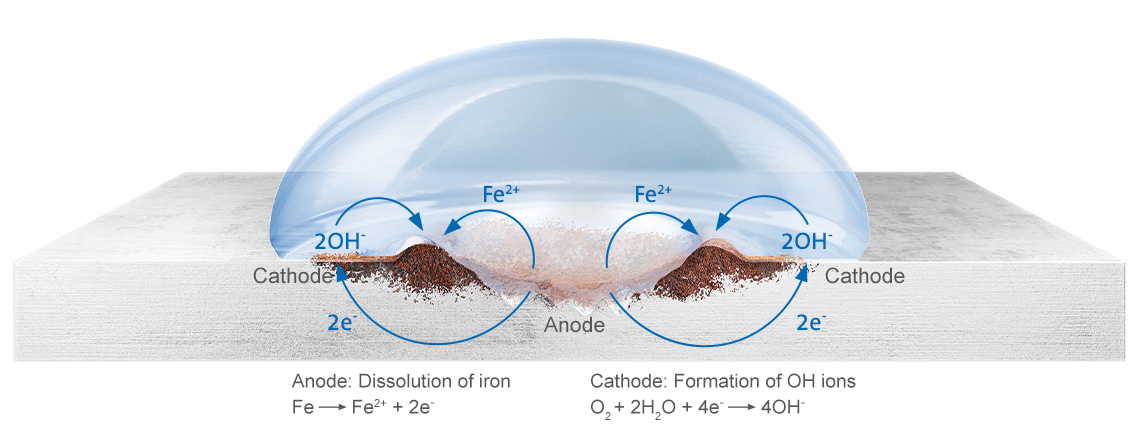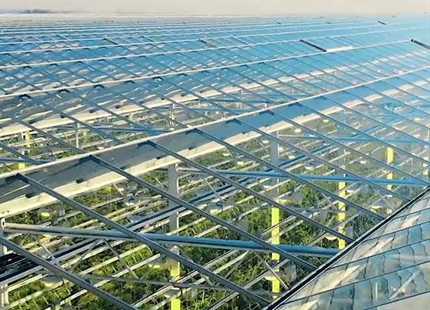Optimum air humidity for warehousing
Wherever products and goods are stored, wherever objects are archived, a comprehensive air dehumidification system protects the owners from the possible consequences of moisture damage such as clumping, mold and corrosion. The reasons for this are related to the release of moisture from the stored goods themselves or to the ingress of outside air and the associated formation of condensationin the respective rooms.
The risks associated with the ingress of external air are even higher for goods stored in cold storage facilities. Ice formation on all room surfaces endangers the safety of the personnel working there. The condensation that arises in this process can damage the stored goods, and the required hygienic standards can then only be ensured at considerable additional expense. Highly functional dehumidification systems not only protect the product quality, they also ensure the necessary efficiency in the operation of storage and cold storage facilities.
Dehumidification — to prevent corrosion of metallic
raw materials and finished goods

Iron cannot rust in the mere dry air. However, when moisture settles on the metal, oxygen (O2) and water (H2O) begin to react to form hydroxide ions (OH-). To balance the electrons required for this reaction, the iron oxidizes, i.e. it releases its electrons, which are then absorbed by the oxygen. This process produces iron oxide. Where the electrons have been withdrawn, an electron shortage occurs and positively charged iron atoms (Fe2+) are released. These migrate into the water droplets and combine there with the negatively charged hydroxide ions (OH-). In the first step, iron(II) hydroxide is formed as a result of different charges. Further reactions with water, oxygen and hydroxide ions result in ever more continuous reactions from which iron(III) oxide and iron(III) hydroxide are formed. They settle on the metal surface and give the rust its typical appearance. Unlike with metals such as aluminum, the process is only stopped when iron is no longer present.
Humidification — so that hygroscopic stored goods
retain their value
 with controlled humidity
with controlled humidity
 with dry air
with dry air
As fruit and vegetables dry out and shrivel up quickly at low temperatures, the right humidity must be ensured. An appropriately sized humidification system in both the stockrooms and the display area ensures that fruit and vegetables remain fresh and salable, with no loss of weight.

Maintaining material quality
Wherever (raw) materials are processed or stored, high air quality is a prerequisite for high material quality. Particles suspended in the air, especially dust, can attack the surfaces of the stored products and components or those still to be manufactured. This can result in high costs, especially for valuable materials (e.g. mahogany woods). In addition, glues often do not cure completely or evenly under dry conditions, which reduces the robustness and service life of the end products. A constant air humidity permanently counteracts such threat of deterioration in quality.

Preventing clumping
No matter whether it is the processing of food or pharmaceuticals: If fine materials such as powders or granulates absorb the water vapor present in the ambient air, this can have negative consequences for the manufacturing process as well as for product quality. Powdered materials can thus clump together and block transport routes which can only be unblocked by extensive cleaning work in conjunction with possible production stops. On the other hand, clumping compromises the desired formulation or dosage of the substances and thus also the effectiveness, taste or consistency of the respective end products.

Szklarnie
Aby uzyskać optymalne plony i zminimalizować ryzyko inwazji szkodników, wilgotność w szklarniach musi być regulowana. Każdy gatunek rośliny ma swoją ...

Hammam, Caldarium i Rhassoul
Hamam to łaźnia parowa, w której odbywa się specjalna ceremonia kąpieli,
i jest ważną częścią islamskiej kultury kąpielowej i fizycznej.
Skupia się...

Łaźnia parowa i prysznic parowy
W dzisiejszych czasach wiele hoteli i klubów zdrowia oferuje zaplecze spa dla dobrego samopoczucia swoich gości i członków:
Basen, sauna, a coraz czę...

Steam bath and steam shower
Nowadays, many hotels and health clubs offer spa facilities for the well-being of their guests and members:
A swimming pool, a sauna and more and mor...

Centrum telefoniczne
Dobra wilgotność powietrza w call center zapewnia nie tylko dobre samopoczucie pracowników, lecz również ich wydajność i zdrowie.Choroby układu oddec...

Muzea
Muzea są skarbcem chroniącym dzieła sztuki i inny dorobek ludzkości. Niezliczone,
często unikalne i niezastąpione eksponaty, są warte wiele miliardó...

Lotnictwo
W branży lotniczej niezbędna jest niezawodna funkcjonalność wszystkich komponentów. Niedostateczna wilgotność może prowadzić do uszkodzeń i usterek e...

Pływalnie
Wysoki poziom parowania wody na pływalniach, szczególnie w połączeniu z panującymi tam wysokimi temperaturami w pomieszczeniu, prowadzi do ogromnego ...

Drukarnie
Nawet jeśli czytanie zaczyna wychodzić z mody, papier pozostaje cennym surowcem. Papier jest potrzebny nie tylko do gazet i książek, lecz także do pl...

Przemysł drzewny
Drewno to naturalny materiał, który „żyje” długo po ścięciu drzewa. Jeżeli podczas składowania i przetwarzania powietrze jest zbyt suche, drewno trac...

